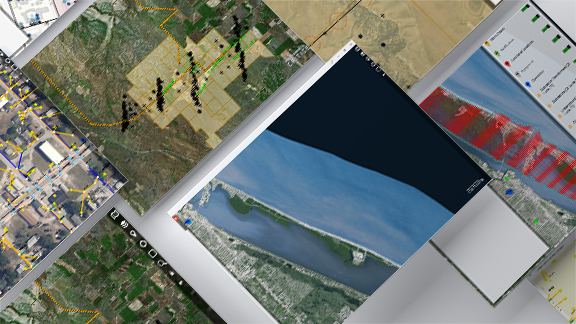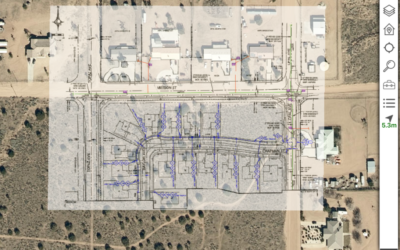How companies can employ location intelligence across the enterprise.
Yet the greatest technology challenge today isn’t the ability to generate data. It’s siloed systems. Many utilities maintain multiple enterprise systems, from enterprise resource management (ERP) to enterprise asset management (EAM), work management (WM), advanced distribution management systems (ADMS), supervisory control and data acquisition (SCADA), and building information modeling (BIM). These disparate databases result in redundancy and inaccuracies. And without an integrated data picture, your staff are left to make decisions with an incomplete understanding.
But with modern GIS, you gain a connected geospatial enterprise. You can leverage the locational aspect of data in any system to integrate information, people, and processes to achieve business value across every department. As a result, you optimize networks, grow the business, and deliver amazing service using timely, accurate, and complete information. And with mapping and location intelligence embedded in your IT infrastructure, the applications and use cases are limitless.

A myriad of GIS use cases
Modern GIS turns location data into insightful intelligence for everyone in the organization, from division executives to departmental staff and field service technicians. You connect customers, assets, networks, employees, the environment, and more to a location to gain a layered, holistic view for a thorough examination. Using custom geospatial applications, embedded tools, web-based portals, and complete mobile solutions, you enable instant access to many forms of data, analytics, and reporting.
This helps reveal relationships, unearth patterns, and make discoveries in ways not possible using siloed systems. As a result, you benefit from deeper insights and understanding for making better data-driven decisions across the organization. In addition, you can communicate, collaborate, and share information internally with other staff and departments, as well as externally with regulators, business partners, customers, and the general public. Here are just a few examples of how modern GIS improves the business of utilities across the board.
Grid modernization: Build a safe, resilient, and reliable smart grid using the latest geospatial innovation. You can optimize grid performance and mitigate against risk using high-powered visualization and location analytics that improve insights on grid behavior and identify potential vulnerabilities. Modern GIS, specifically the new Esri Utility Network (UN), provides higher fidelity data to better model real world connectivity and integrate with critical business systems like ADMS.
Design and engineering: Capturing detailed asset information as they are being constructed can be difficult. Modern GIS works across the organization, removing siloed information by linking data using location to multiple departments outside of design and engineering. Gain a seamless, integrated view of data combined with powerful tools to improve workflows and automate activities from construction through to maintenance and replacement.
Network monitoring: Deliver an innovative smart grid using an advanced data model to combine digital sensors, network and data management, advanced analytics, and real-time data feed. Leverage aerial and even satellite imagery to detect potential network problems and proactively replace assets. And run risk models and other analyses to ensure optimal performance.
Safety and compliance: Gain an accurate understanding of asset locations, inspection dates, and more using a holistic geospatial view. Reduce the risk of damage and disruption (e.g., ruptured or over-pressurized gas mains underground) with location analysis that helps locate and identify previously unmapped assets. In addition, improve asset reporting to meet regulatory compliance and avoid potential violations.
Vegetation management: Improve network and service reliability and resilience using geospatial tools that support field apps and incorporate data from third parties. Visualize current and projected vegetation, perform risk models for fire, floods, and other extreme events, and build dashboards and reporting tools. Effectively monitor and remove only the trees and vegetation to lower risk while preserving the environment.

Leak management: Gas and water utilities can connect GIS to their other enterprise systems to reduce commodity losses and maximize long-term capital expenditures. GIS helps with data management analysis to proactively identify potential risk and respond faster and more strategically to maintain infrastructure and quickly repair damaged assets.
Customer care: Customer reps can use GIS web apps that provide map-based interfaces to data they need to handle calls, answer questions, and access information around service disruptions, repairs, construction timelines, field service activity, and more. Utilities can proactively supply online map apps for customers to report an outage and view restoration status easily.
Emergency response: Utility leaders, emergency command, and field staff can access location data and maps to respond to critical events, prioritize repairing or restoring essential facilities, and communicate with stakeholders and the public. Map dashboards in the operations and emergency centers provide real-time situational awareness through a common operating picture. They can also use native mobile GIS applications to operate in any environment, including under stressful conditions when digital service is down.
Clean energy investment: Integrate systems, link data, and perform multivariant analysis to identify renewable clean energy opportunities. Modern GIS can help you understand your supply chain and events closer to real-time to plan and respond effectively. Enhance project management, manage site selection, construction, maintenance, and more with GIS. Analyze airspace, terrain slope, wind speeds, flood plains, proximity to power lines, soil composition, and infrastructure costs.
Field operations: Employ modern mobile mapping that works online and offline so your field workers can perform tasks faster and with greater efficiency. Mobile solutions give staff intuitive, zero-training access to your existing GIS data and tools. Improve field and back-office business processes using redlining, as-builting, and more. Reduce time wasted finding information to increase safety and field efficiency using maps available with or without cell coverage.
Partner with a leader in location
IT projects, including enterprise GIS implementations, fail for many reasons. McKinsey states that only 30% of digital transformation projects succeed, and Forbes reports that 90% fail to deliver any measurable ROI. Poor planning, lack of internal knowledge or resources, scope creep, and poor adoption strategies can play a role. But they don’t have to.
For utility businesses looking to embark on their GIS modernization endeavor, Locana can help. Our staff maintains deep geospatial and IT knowledge built on decades of enterprise implementation service in the utility market, including modern geospatial software like Esri ArcGIS Enterprise and the Utility Network. We can help guide your strategy, develop mapping and analytics, integrate systems, and enable long-term success.
Locana maintains a unique delivery model that caters to the client’s exact business needs and fits any within corporate IT systems such as SAP, Salesforce, and others. Moreover, our experience working with enterprise IT implementors like PricewaterhouseCoopers means we can fit seamlessly with your larger digital transformation initiatives.
As a result, we can design, implement, configure, and connect GIS with your business systems with speed and efficiency. You can spatially enable the enterprise and deliver geospatial insight for any use case.
Locana enables customer success with:
- Extensive utility, GIS, and IT consulting experience
- Proven track record delivering self-sufficient projects
- Proprietary and open source technology expertise
- A partner dedicated to transparency and ownership
- Side by side collaborators with a flexible approach
***
Want to learn more about GIS modernization and its benefits? Read our recently released white paper. Or visit our services and industry pages.


